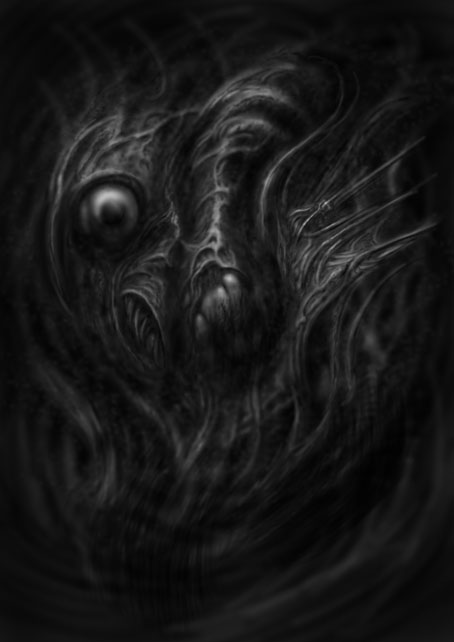I never used a graphics tablet for drawing, in the past if I needed to draw something I’d use pencil and paper then scan the results. In recent years, however, I’ve grown dissatisfied with this process, especially after I rearranged my work area and packed away the space-hogging Ikea table I used to use as a drawing surface. This left me without a decent drawing area so this week I’ve finally capitulated and bought an Wacom Intuos tablet. The Giger-esque mess above is the result of playing around in Photoshop for a couple of hours. Having spent years using the blunt instrument of a mouse for Photoshop painting the combination of pen and tablet had immediate benefits, and I’ve found them both very easy to use. The sensitivity of the pen is impressive, something I was always dubious about. With the right brush selection it’s almost exactly like using a pencil or pen. Almost. I’m still not feeling as entirely in control of the end result as you do when drawing on paper, but I’ve not even used the thing for a whole day yet so I imagine that will change. I’m also surprised by how quickly the nib wears down; fortunately the pen comes supplied with a small stock of fresh nibs. The next week or so will be spent in further experimentation so if any interesting results materialise I’ll post them here.
6 thoughts on “Intuosity”
Comments are closed.


I’ve still got an ancient Intous tablet bought about 10 years ago, and it still works like a bomb. I’d love to try a newer one, I’m sure it’s got some useful features. It’s not the same as drawing on paper, but you do get used to it.
I usually start my work on paper and scan it in to do the rest digitally, as for some reason I find I cannot do rough drawing digitally. My brain cannot seem to function in the right way — no idea why.
I can’t yet even consider the leap to working from scratch onscreen. Frankly it scares me, I think it’s the disconnect from watching my hand do the drawing work as it has done for years, think it would feel like learning to draw again or drawing with my non-drawing hand. Still umbilically connected to my scanner. Good luck stepping into the void!
I wonder what M.C. Escher could have created with one of these tablets-shades of Drawing Hands- or my favorites Dewdrop and Puddle.
This “Eye of Chaos” is a great beggining, John.
I’ve been looking around for ways to transfer some 500+ B&W line drawings on paper to an electronic format and don’t mind admitting my ignorance of most of the technology out there…I know you are not in the advise business, but in this case, if you have the time…
I’ve never actually held one of these tablets or seen one in use – is there a source of illumination on the drawing surface (similar to a lightbox) so that one could actually lay a drawing on top and trace through to the device – does the pen have to touch the surface or does it work by registering the applied pressure of the nib…John
Hi John. No, there’s no lightbox effect, you look at the screen, not the pad. It’s very much a tool for drawing, not transferring artwork. The easiest method for the latter is to buy a scanner or take the artwork to a facility with scanning services. Flatbed scanners are very cheap these days. No idea what to recommend, you’d have to search for some buying guides.
As for tracing something using the tablet, yes, this works–the pen connects through the paper–but I’d personally find it easier to scan whatever required tracing then trace it on the screen using a Photoshop layer.
Thanks John, that’s very helpful, I understand now – I think traditional scanning is my best bet for existing work on paper – I may get a tablet for future projects…